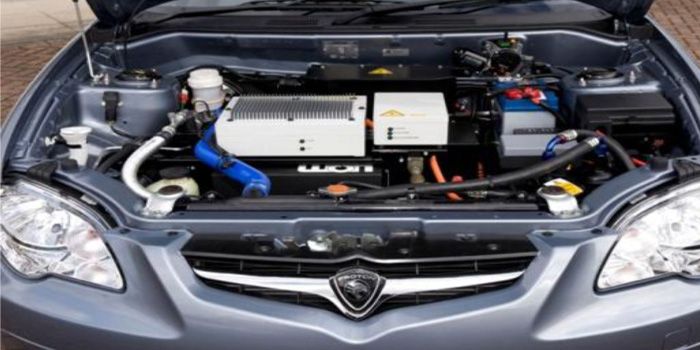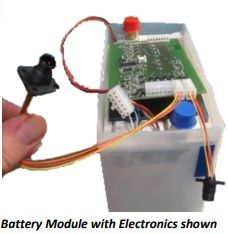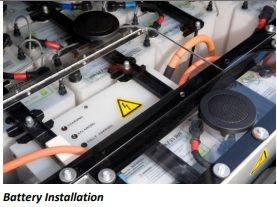The High-Speed Electric Vehicle
When Proton Cars of Malaysia decided to build two electric cars, only one company could deliver the battery pack including cells and battery management system with the necessary quality and within the tight time schedule.
Introduction

Late last year, PROTON decided to investigate the viability of the electric car by having two electric vehicle prototypes made for evaluation. What was remarkable about this was 3 months later they had two driving demonstrators for show in various exhibitions around the world. Here is how it happened.
PROTON decided to use two of its most popular saloons as the donor vehicles: the Saga, a compact saloon and the Persona, a modern family sedan. The conversion work was done together with PROTON’s Lotus Engineering subsidiary. The starting point was to set some performance targets such as range, maximum speed and acceleration.
The Saga was targeted to achieve a 0-60 (97km/h) time of <11sec and the Persona <13sec. Both cars had a target maximum speed of 100mph (160km/h). The real differentiator was range whereby the Persona was targeted to achieve a 100mile (160km) range and the Saga a 60mile (97km) range.
Technical Solutions
PROTON took the unusual root of keeping and using the original gearboxes in the cars instead of the more common practice of installing a simple reduction gearbox. The rationale behind this was to make a vehicle that drove like a conventional car with the difference that the clutch was not needed to launch the car from standstill.
The decision created some unique challenges of its own. The gearboxes were rated for 150Nm continuous torque, whereas the UQM 125 motor used had a peak torque rating of 300Nm. Here, Lotus Engineering’s unique experience in calibrating electric motors came to the fore. The motor performance was matched to the gearbox to prevent damage and provide good driving characteristics.
A temporary torque boost feature was also included whereby under acceleration, up to 180Nm could be delivered for a short period of time. The motor and inverter from UQM was rated for 45kW continuous and 125kW peak giving spirited performance. In addition to the traction motor and inverter, an electric steering pump, vacuum pump for the brake servo and an air conditioner compressor were all installed under the bonnet. A Lead Acid battery was also used to provide a low voltage circuit for the switching electronics and to ensure that the main battery pack could be completely isolated when the vehicle was shut down.
A really clever feature was the incorporation of an adjustable regenerative braking setup, whereby the driver could adjust the level of regenerative braking, which would be felt as engine braking, from a simple knob on the dashboard.
The Heart of the Vehicle
The heart of an electric vehicle is the battery pack, this, together with the switching electronics was supplied by Lithium Balance. To achieve a good weight to energy ratio, Kokam prismatic cells were selected, which presented the challenge of mounting the pouch cells in a suitable battery pack. To do this, LiTHIUM Balance put together a plug and play battery concept, with built in management electronics. The result was a family of intelligent battery modules each containing eight cells and a local monitoring board from the battery management system, housed in a lightweight polyethylene box. The cells were protected by a rubber layer to minimize vibration.
The battery modules could be connected together in series to provide the necessary system voltage but more importantly, the integration of the local monitoring electronics into the battery module removed the cable spaghetti between the individual cells and the battery management system, replacing them with a four strand serial connection, providing the required data communication between the battery modules. The battery modules were made in two variants, one with 30 volts (8- series) and the other with 15 volts (2-parallel x 4-series). The 15 volt variant had double the capacity of the 30 volt variant in amp hours and was used in the Persona.

As the vehicle was expected to be primarily driven in hot climates, no battery heating provision was put in place, however, a sophisticated cooling arrangement, using airconditioned, cabin air together with electric fans, was installed. The system was controlled by the battery management system and operated according to cell temperature. The original vehicle radiator was used to provide cooling for the motor and inverter. The vehicles were equipped with 3.3 kW onboard chargers.
Proton had a number of specific wishes relating to the CAN bus and the provision of some warning and status LEDs, which could blink fault codes if required.

Testing
An important part of the project was testing and validation of the final product. This started with a dyno test to benchmark range according to the New European Driving Cycle (NEDC). Acceleration and maximum speed were also tested. Testing was also performed to validate the safety and reliability of the complete powertrain including the battery pack.
Finally, a ride handling evaluation took place, where the driving characteristics of the vehicles were investigated.
This is a key point in any conversion as it is always a challenge to package the batteries without adversely affecting the vehicle handling characteristics. Subjectively, the Saga with its lighter battery pack provided the better drive.
In summary, 3 months after the decision was taken, two completely usable electric vehicles were ready to be driven.
Those involved in the project were clear, such a tight time schedule was only achievable with the help of fast reacting and agile sub-suppliers such as LiTHIUM BALANCE who made the battery pack and battery management system.
There can be no question about PROTON’s commitment to electric vehicles. We look forward to seeing more electric Proton cars in the future.
We would like to thank Proton Edar Sdn Bhd and Lotus Engineering for their input to this article.